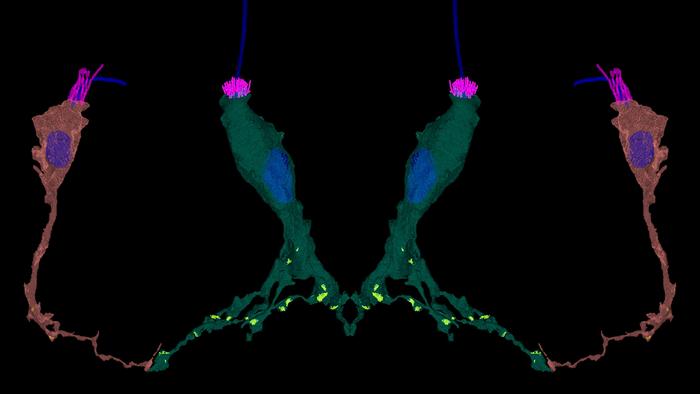Researchers at the University of Arkansas have published groundbreaking findings that challenge our understanding of sensory neurons, particularly in relation to the ancient role of certain genes shared between humans and sea anemones. Their work, which centers on the polycystic kidney disease 1 (PKD-1) gene, suggests that our current insights into mechanosensation—our ability to hear and feel touch—may be deeply rooted in evolutionary biology, extending back over 580 million years.
The research focuses on the mechanosensory hair cells located on the tentacles of sea anemones. These hair cells, akin to those found in the vertebrate inner ear, serve a dual purpose. While vertebrates utilize them to detect sound vibrations, anemones leverage this cellular architecture to sense movements in their aquatic environment, a crucial ability for catching prey. By employing advanced techniques, the researchers traced the lineage of the PKD-1 gene, previously linked to kidney disease in humans, to the foundational biology of these marine organisms.
Through meticulous analysis of the evolutionary pathways and developmental processes of these sensory receptors, the team has uncovered a pivotal connection between the gene that plays a fundamental role in human kidney function and its ancient counterpart in cnidarians, a group that includes jellyfish and corals. This resemblance posits PKD-1 as a primordial sensor for fluid movement, hinting that the capability to perceive environmental changes through mechanosensation predates the divergence of bilateral animals and cnidarians, suggesting a shared, complex ancestry.
The study, published in esteemed journal Nature Communications, details how researchers identified two distinct types of mechanosensory neurons on sea anemones, contradicting previous assumptions about the uniformity of these cells. The discovery of this cellular diversity heralds a significant paradigm shift in how we view the mechanosensory systems of both cnidarians and more advanced vertebrates, indicating that the evolution of these systems might have been more intricate than previously accepted.
Additionally, this research places the spotlight on cnidarians as vital models for studying human evolution. The similarities between gene functions in these organisms and those in humans provide a compelling framework for understanding various diseases, including genetic disorders. As organisms that diverged from our common ancestors long ago, cnidarians retain essential genetic traits that echo throughout the animal kingdom, offering insights that could pave the way for transformative research into human medical conditions.
The implications of this work extend beyond mere academic inquiry. Ph.D. student and lead author, Baranyk, articulated the extraordinary journey undertaken by the research team, emphasizing that this publication is more than just a scientific paper; it symbolizes years of dedication, experimentation, and collaboration among students under the mentorship of Dr. Nagayasu Nakanishi, the leading researcher on this project.
Dr. Nakanishi expressed his excitement for the culmination of their efforts, noting how this research exemplifies the trials and triumphs that characterize scientific exploration. These findings not only enhance our understanding of fundamental biological processes but also inspire future generations of scientists to delve deeper into the complexities of evolution and mechanosensation.
The breakthrough discoveries detailed in the study are pivotal for aspiring researchers and students in the field of biological sciences. The intricate interplay of evolutionary genetics observed in cnidarians reveals a shared cell-type diversification that invites further investigation. Researchers are now encouraged to explore the mechanisms behind these similarities, potentially unlocking new pathways in sensory biology.
Moreover, the rich history of cnidarians in evolutionary biology positions them as essential subjects for understanding the development of complex traits in more advanced organisms. By studying their mechanosensory systems and the genes that govern these processes, researchers can glean insights into the evolution of sensory organs and their functions across species.
As the scientific community continues to dissect and comprehend the layers of evolution that led to modern vertebrates, the relevance of this study cannot be overstated. The connection between a gene implicated in kidney disease and its ancient origins in cnidarians opens new avenues of thought about the evolutionary pressures that shaped sensory systems. It is a compelling reminder that our shared biological heritage is both intricate and profound.
In conclusion, the advancement made by the researchers at the University of Arkansas not only sheds light on the role of PKD-1 in mechanosensation but also serves as a testament to the power of collaborative scientific endeavor. By illuminating the connections between genes and their cellular functions across diverse taxa, this research challenges preconceived notions of evolutionary simplicity and underscores the remarkable complexity inherent in the history of life on Earth.
Subject of Research: Cells
Article Title: Structural, molecular and developmental evidence for cell-type diversity in cnidarian mechanosensory neurons
News Publication Date: 10-Feb-2025
Web References: Nature Communications
References: Nakanishi, N., Baranyk, J. et al. Nature Communications.
Image Credits: Nagayasu Nakanishi
Keywords: mechanosensation, cnidarians, PKD-1 gene, evolutionary biology, hair cells, sensory neurons, animal evolution, human health, science research, Nature Communications.
Tags: ancient gene functionscnidarian sensory receptorsevolutionary biology of sensory systemshuman kidney disease researchimplications for understanding human biologyinterdisciplinary research in biologymarine organism biologymechanosensation in sea anemonesmechanosensory hair cellsPKD-1 gene evolutionsensory neuron evolutionvertebrate inner ear comparison





